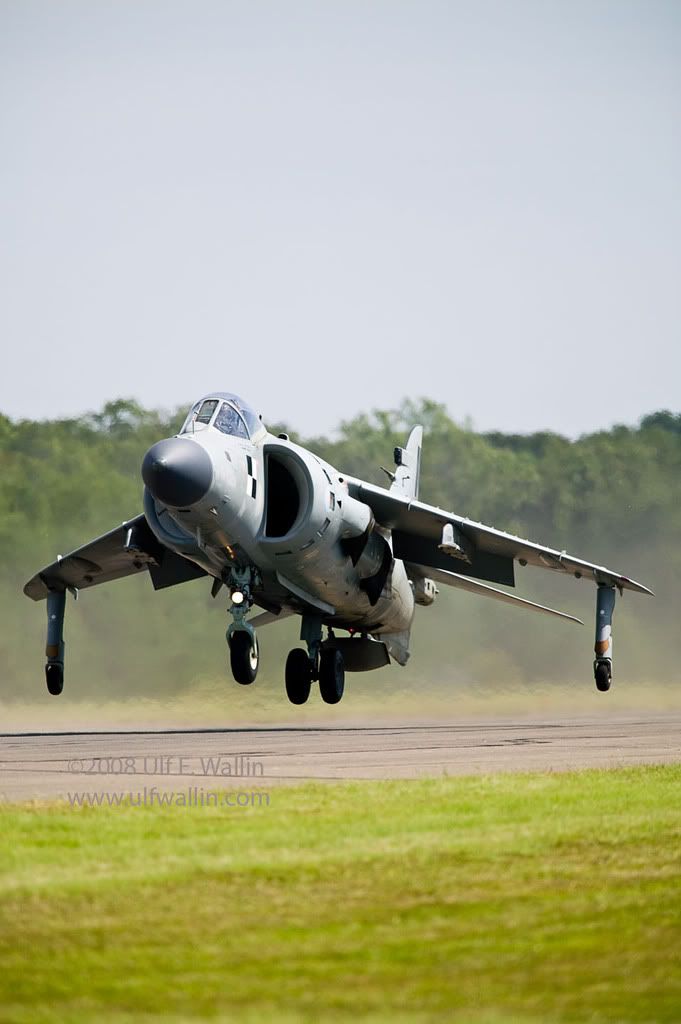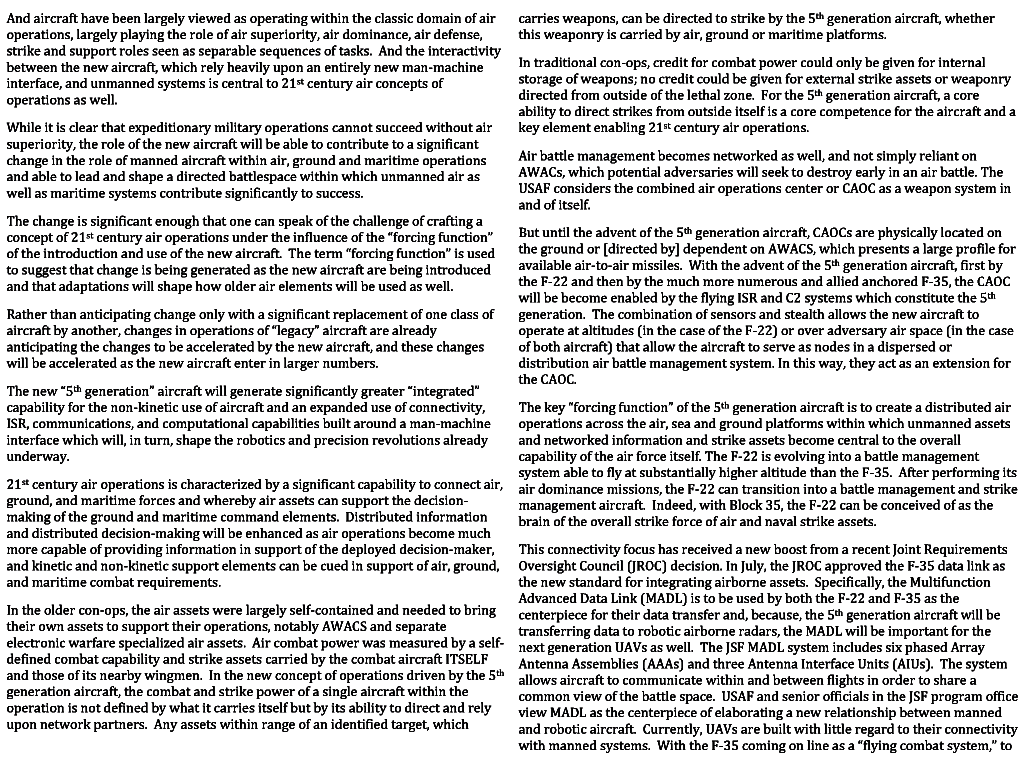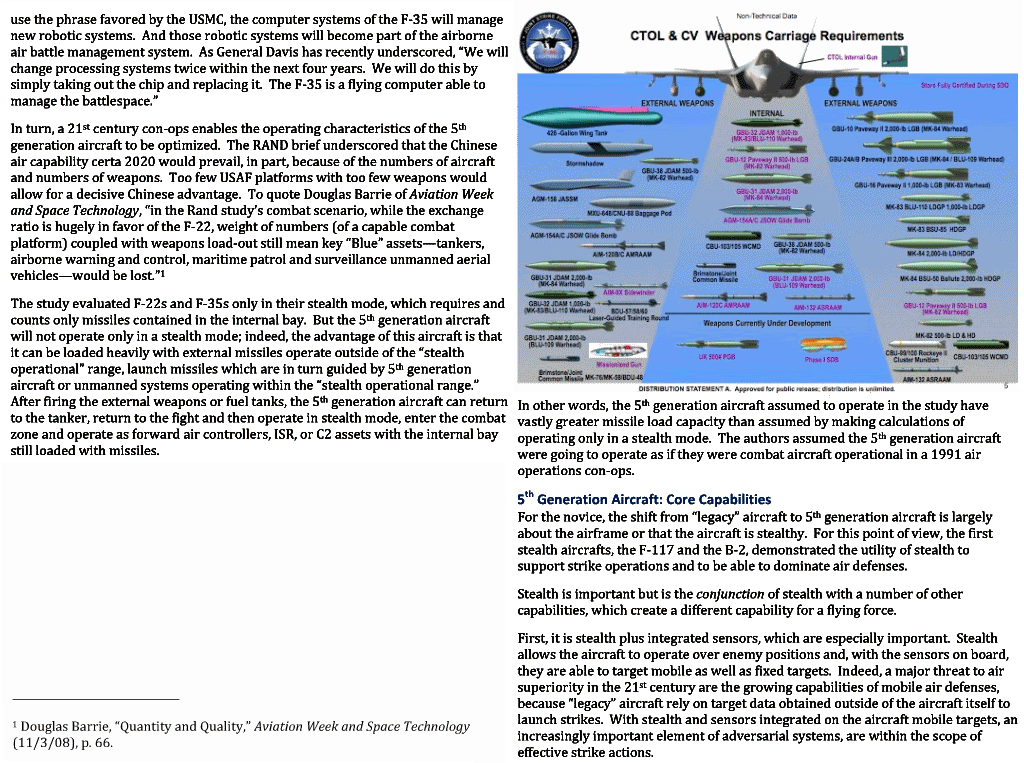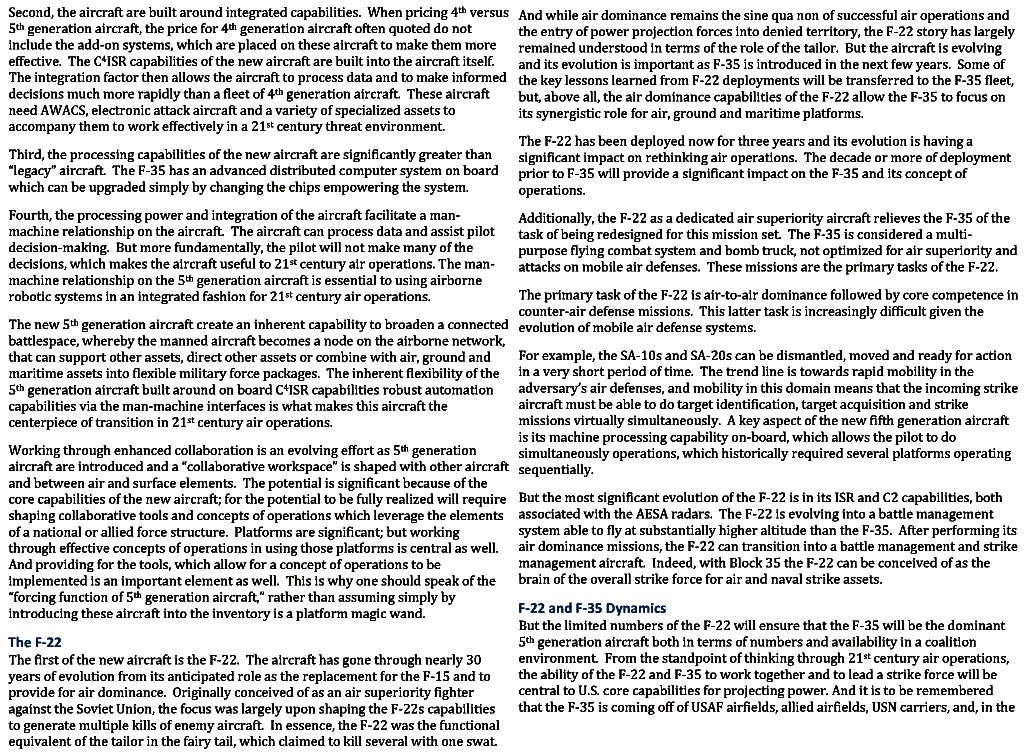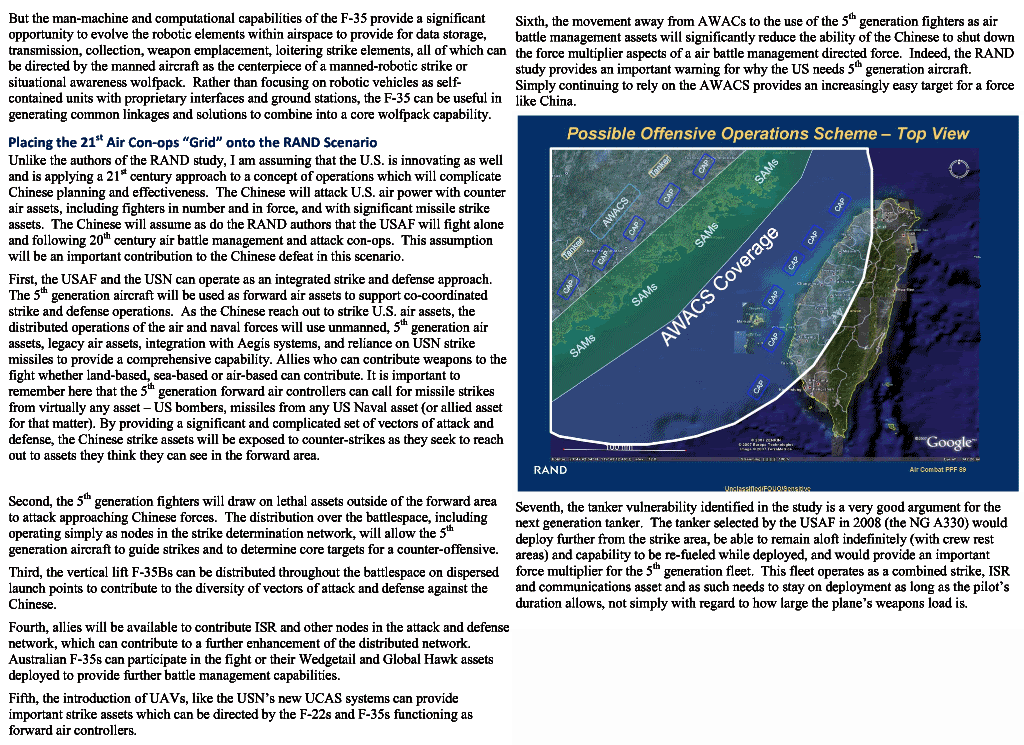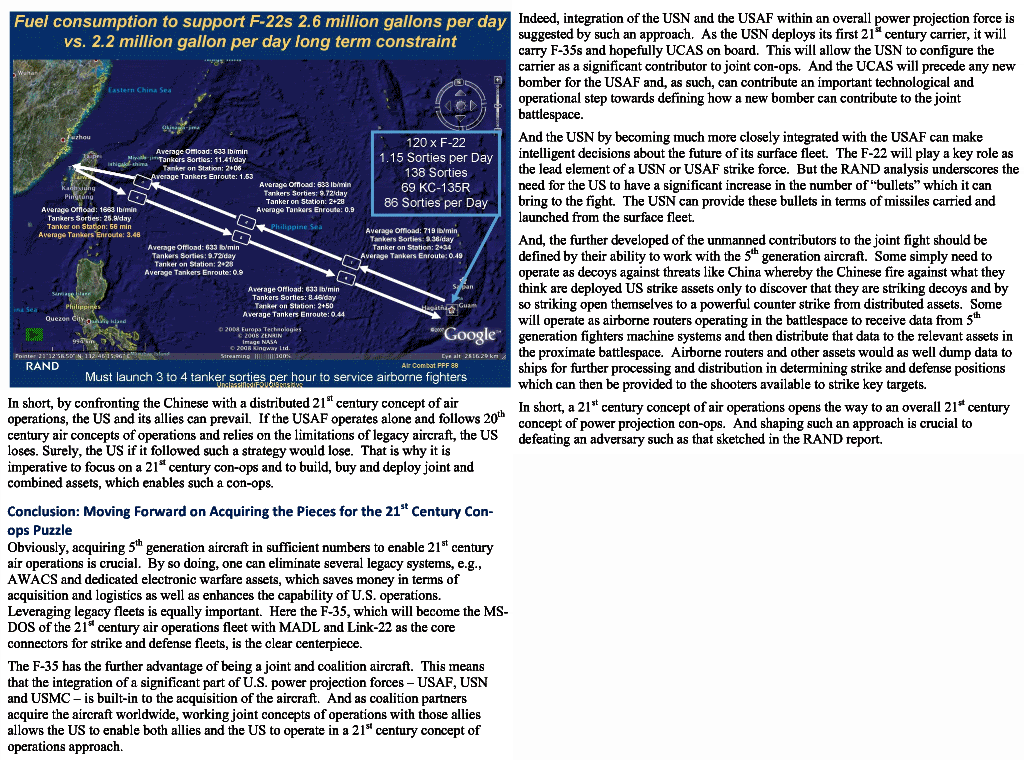|
|
Post by Leyland P75 on Nov 7, 2008 18:51:59 GMT 12
Oldbloke,
Great post! Knowing a little about radars and therefore jamming you're correct in saying that they active ECM can in fact be tracked. As a matter of fact, running around with your jammers on in only going to alert all and sundry of your presence, so it's kinda difficult to understand why you'd do it in an A2A situation, particularly in the, as mentioned, small RCS aircraft. The primary utilty of such countermeasures seems to be against SAM systems anyway, as they buy you that vital time to get out of the threat bubble. The purpose of active ECM is to create enough "clutter" to buy a little time so, and I could be very wrong on this (and please correct me of I am) the primary utility of the system in an A2A engagement would be once you know the missiles are flying. Such clutter might confuse a missile in the terminal run by making the aircraft actually appear very much larger, not smaller, than it actually is.
No need to apologise for anything, I might easily apologise for being a JSF naysayer. I'm not, I think that, in and of itself, it will be an excellent aircraft (although I am jumpy about the power to weight ratio). My main issue is that it is being designed to be all things to all people. This aircraft is being designed to replace such disparate aircraft as the A-10, F-16, F-15, F-18 and AV-8. By being a jack of all trades it will probably be a master of none. So in Australian service, it will need to be an interceptor. In US service the very same plane will need to be a close support plane. I don't believe that it will be as capable an interceptor as say an F-15, nor as capable at close support as an A-10. No so much a problem as an interceptor for the US as they'll have the F-22, but what are they going to do for that relatively slow flying plane that can put down precision fire with dumb bullets/bombs on moving infantry, truck and armour?
|
|
|
|
Post by Leyland P75 on Nov 7, 2008 19:16:28 GMT 12
Another thing.... I've heard that the real utility of the AIM-9 was not so much in scoring hits, which apparently they weren't so good at, but causing the enemy to take evasive action, thereby giving you time to close for a Sidewinder kill. Is this the case? If so it would seem that if AMRAAM and the like can increase the likelihood a hit at BVR range we can expect that the average "Range of Kll" will also increase. I'm off to Tassie this week, so you've got exactly ten days of peace without me. Make the most of it!  |
|
|
|
Post by FlyNavy on Nov 7, 2008 19:56:37 GMT 12
Just to jump in about the 'jack of all trades' JSF. As long as it is better than the competition in those trades (that are relevant to the competition - such as defending against a better fighter for example) it does not have to do much more than that. Of course it has to prove itself.
The point about being affordable and good is key. We cannot buy or afford F-22s unless the USofA gives them to us for free. If they did then what would that mean? An open question for sure.
The early AIM-9B Sidewinders were not that great. The AIM-9X of today is quite a different reliable missile as pointed out earlier in this thread.
If you go to Tassie make sure the Mainlanders are going to let you back in. ;D
|
|
|
|
Post by FlyNavy on Nov 7, 2008 23:22:43 GMT 12
peter75, If you don't know of this forum then go there to this page at least to have some 'radar lurv': www.t5c.biz/showthread.php?t=7105&page=6& TAhDahhh: www.t5c.biz/showthread.php?t=5127&page=5"But my problem is that clowns like Herr Flopp keep arguing that somehow the Russian's have managed to develop super weapons in spite of severely limited budgets and a lousy domestic computer industry. It just doesn't add up. The area that actually makes a difference today is in hardware and software integration, not raw performance characteristics. So what if the Russians can build an AAM that can fly 400nm, if the ruddy thing is being guided by onboard computers so archaic that they can be spoofed with no effort by modern Western-ECM built with modern Western-computers? Compare that to AMRAAM AIM-120C-5/7 - which is fitted with the best seeker/on-board processing that money can buy - and I know which one I'd rather purchase. This is also the key point of the JSF. Who cares if the thing is slightly short legged (and it isn’t really)? JSF will have the most sophisticated onboard computers of any fighter ever built, and they'll be integrated via truly sublime software. The result will be an aircraft with unsurpassed situational awareness, able to simultaneously perform multiple functions, and with an integrated onboard logistics and system health monitoring system which allow increased sortie generation rates and improved reliability. In that context what the hell does a steam-powered Flanker derivative run by computers that barely deserve the title have over a JSF? Sure take them seriously as a threat, but keep perspective." & "The performance figures APA use to justify their position are simply wrong too. The F-35 has a better power to weight ratio than current and planned SU-30 variants. It has a lower wing loading, larger control surfaces, a "clean" airframe and FAR superior situational awareness. These attributes are all important in the "knife fights" that "Borat" over at APA claims that real pilots describe these incidents. Anyway, as if the SU-30's of which Country is of course unstated, are going to defeat the F-35's BVR capabilities anyway... This article is sheer nonsense. I asked a USAF E-3C battle commander at Avalon, how concerned they were about the Russian anti-radiation missiles that feature prominently in that article and he stated, "you mean the ones that can't target anything that doesn't emit radiation"? I said, "er, yes". He said, "It is a simple matter to switch off a beam in that direction and we're well aware of those types of threats"..." |
|
|
|
Post by FlyNavy on Nov 8, 2008 7:36:22 GMT 12
|
|
|
|
Post by FlyNavy on Nov 8, 2008 7:52:27 GMT 12
|
|
|
|
Post by oldnavy on Nov 8, 2008 9:06:00 GMT 12
peter75, thanks for your kind words and have a great Tas Break!
I understand what you mean on multi role. It is a real question asked by many in Defence departments across th globe. Having been born and bred with multi-roles, my conversation points on that are simple questions. Is the pure fighter (F22 say) that much better at Air to Air than the F35 to warrant all the additional expense? Similarly, are the bombs dropped by a pure bomber (F111 say) that much more accurate than the F35? Remembering that if you go down the pure fighter path you will also need a pure bomber. It all costs heaps. I argue the F35 will be a pretty respectable and cost effective fighter, and using modern AG weapons it will be better than the F111 in its wildest dreams. What the F35 may lack in capability as a pure fighter will be made up for by the numbers which will be affordable. (Go in mob handed...)
The radar missile query is a good one. The semi active radar missiles tended to have a low PK. They were the AIM 7 and Skyflash etc. The problem with semi active missiles is that the launching fighter needs to stay locked in single target track (STT) throughout the time of flight of the missile. This means the target aircraft will have an RWR cue from the point of launch and can start avoidance manoeuvring. Everyone unlocked (no RWR indication) in the target formation is able to manoeuvre agressively towards the attackers knowing they (the attackers) can only see STT targets. The poor old STT targets (missile soaks) have to depart the scene as quickly as they can, or break the STT lock during the time of flight of the missile usually by notching or decoying. In the meantime, it is usually possible for WVR fighters equipped with the AIM 9 Sidewinder (or similar) to manoeuvre close enough to the semi active missile shooters whilst remaining unsighted to the attackers and hose off a few missiles.
Please NB: I acknowledge for every offense there is a defence, and semi active missile shooters have many tricks up their sleeves to defeat the WVR shooter threat as well. One of their tactics is definitely to use the semi active missle (or even just a radar lock!) to force the WVR targets to manoeuvre, thus making them more predictable.
The advent of active missiles capable of being supported to the target using track while scan (not STT) means the alert time for the target is less and the point of launch is less well defined. The missile's radar when it goes active (autonomous) is also harder to detect on RWR. None of this means active missiles have 100% PK. Defending fighters have many out clauses/tactics. When you shoot one, and with what PK, is also a part of the game.
Flying fighters is definitely the sport of kings...
|
|
|
|
Post by FlyNavy on Nov 8, 2008 13:13:58 GMT 12
Thanks for overview ShinyTrident: "Mind Games" (forever) springs to mind as a learning tool for opposing forces during peace time wargames (as long as one has the superior tech): (bagging indeed) Mind Games by John Lennon "We're playing those mind games together Pushing the barriers, planting seeds Playing the mind guerrilla Chanting the mantra, peace on earth We all been playing those mind games forever Some kinda druid dudes lifting the veil Doing the mind guerrilla Some call it magic, the search for the grail" www.bagism.com/lyrics/mind-games-lyrics.html |
|
|
|
Post by FlyNavy on Nov 8, 2008 13:57:04 GMT 12
|
|
|
|
Post by FlyNavy on Nov 8, 2008 19:51:41 GMT 12
Spin me anotherie - just like the otherie - do: www.flightglobal.com/blogs/the-dewline/Statement from Nellis AFB Public Affairs: "The YouTube videos "IAF SU-30 MKI Red Flag Lecture Part 1 & Part 2" were of Colonel Terrence Fornof, an F-15 pilot and the Director of the Requirements and Testing office at the United States Air Force Warfare Center, Nellis AFB, Nev., giving a private impromptu briefing in August 2008 to local Daedalians. The Daedalians are a group of retired military pilots. Col. Fornof did not mean to offend any U.S. allied forces, as he knows firsthand the importance of training with allied forces and the awesome firepower they bring to the fight. His comments during this briefing were his personal opinions and not those of U.S. Air Force Warfare Center or of the Air Force." & "Monthly Meeting - 9/17/2008 6:45:54 PM Fellow Daedalians, The upcoming weeks will offer several events at Nellis AFB if you are interested. I have included some event notes below but first, let me tell you about the September 24 meeting. We are joining with the Thunderbird Chapter of AFA to host a USAF Warfare Center panel to discuss "The Future Fight". After our dinner of London broil, Brig Gen Hoog will introduce the panel members, who then will discuss how the Warfare Center is preparing for the future fight today. After a short presentation, they will open the floor up for questions and answers. It should be a very informative presentation that you will not want to miss." |
|
|
|
Post by oldnavy on Nov 9, 2008 10:17:46 GMT 12
Wow! A Colonel with such a lack of political awareness! That is really scary! I wouldn't mind betting that if his career is recoverable he gets some compulsory media training next week...
|
|
|
|
Post by FlyNavy on Nov 11, 2008 9:45:34 GMT 12
Airpower experts enter the merge in F-35 dogfight debate By Stephen Trimble on November 10, 2008 4:16 PM www.flightglobal.com/blogs/the-dewline/2008/11/airpower-experts-enter-the-mer.htmlTwo academic studies based on the infamous Rand airpower analysis are out today. Both illuminate both sides of the polarized debate about the F-35's relevance as a future warfighting tool. According to these analyses, the F-35 is either the vanguard of a new way of fighting air battles or a woefully underachieving dog of a dogfighter. The anti-F-35 crowd is represented by self-styled Australian airpower expert Carlo Kopp. He writes: www.ausairpower.net/APA-2008-08.htmlIt is now abundantly clear that the Joint Strike Fighter is not going to be viable in Beyond Visual Range air combat, just as it was clear from the outset that it would never be a serious player in Within Visual Range air combat.But representing the pro-F-35 side is Robbin Laird, who has served as a close adviser to both former Secretary of the Air Force Michael Wynne and the US Marine Corps aviation leadership. His study is entitled, " Reflections on the RAND Project Air Force Brief: Air Combat: Past, Present and Future", and here's an excerpt: www.scribd.com/doc/7862375 (this link should be accessed from / at the 'dewline' website - first URL in this message - where it can be seen in a very difficult to read format - this SCRIBD format is just so bad it should be banned) In the new concept of operations driven by the 5th generation aircraft, the combat and strike power of a single aircraft within the operation is not defined by what it carries itself but by its ability to direct and rely upon network partners. Any assets within range of an identified target, which carries weapons, can be directed to strike by the 5th generation aircraft, whether this weaponry is carried by air, ground or maritime platform.
|
|
|
|
Post by FlyNavy on Nov 11, 2008 10:16:24 GMT 12
|
|
|
|
Post by FlyNavy on Nov 11, 2008 10:28:34 GMT 12
AND the fun of Utube Video comment continues: www.flightglobal.com/articles/2008/11/10/318544/pilots-youtube-indiscretions-could-trigger-wider-air-power.htmlDATE:10/11/08 SOURCE:Flight International Pilot's YouTube indiscretions could trigger wider air power debate By Stephen Trimble An unidentified US Air Force Boeing F-15 pilot has become an instant YouTube star, unwittingly sharing his explicit insights about the technical and aerodynamic capabilities and limitations of several of the world's best fighters. While perhaps hurting the pride of the French, Indian and Russian air forces, the USAF pilot's straightforward and sometimes politically incorrect observations are likely to contribute to the ongoing debate about the future of air warfare in the US military's requirements and budget pecking order. The precise circumstances of the pilot's lecture to a small audience are unconfirmed. He may have known he was being videotaped, but his comments were not likely to be intended for wide distribution. It is clear that the pilot participated in the recent Red Flag exercise, which also drew India's , French Dassault Rafales and South Korean F-15Ks. He says the USAF wanted to atone for its abysmal showing by mostly inexperienced pilots against the Indian air force's best Su-30K pilots at a 2004 exercise called Cope India. Four years later, the service's pilots impressed with their professionalism and skill at Red Flag, but the USAF pilot is proud to report: "Amazingly, we dominated." The F-15 pilots used their simulated combat experience against the thrust-vectoring capability of the Lockheed Martin F-22 to exploit the Su-30MKI's main weakness in post-stall manoeuvring, the pilot says. He adds: "So we start to pull in on him, and then all of a sudden you start to see the [Su-30's aft-] end kick down and he starts doing vectored thrust. But now he starts falling out of the sky. He's falling out of the sky so fast that you don't even have to go up. You just have to pull back on the stick a little bit, pull the throttle, go to guns and come in and drill his brains out." The pilot notes that the F-15 dominated the Su-30MKI in dogfights so much that the USAF is concerned their success could have budget repercussions. "Now what I'm scared of is Congress is going to hear that and go - 'great, we don't need to buy any more airplanes'. No, no, no, no," the pilot tells an audience that includes retired air force leaders. He adds that "it's only a matter of time" before the Indian air force Su-30 pilots learn how to overcome the F-15 tactic used so successfully against them at Red Flag. Moreover, the pilot explains that the F-15s and Lockheed Martin F-16s face several other vulnerabilities in modern combat. He confirms hints that the USAF's long-range radar-guided missiles are susceptible to jamming, blunting their edge in beyond-visual-range combat. The Indian air force's top-line Su-30MKI fighter is not the USAF's only worry. The USAF pilot also says the Indian air force's RSK MiG-21 Bison aircraft, modified with Israeli radar, active radar missiles and electronic jammers, are now nearly "invisible" to the F-15's and F-16's current mechanically scanned arrays. The Indian MiG-21 pilots can use their jammers to sneak past the USAF radar screen and engage the F-15s and F-16s in dogfights, where the outcome is far from pre-determined. "The MiG-21 had the ability to get in the scissors with you at 110kt [200km/h] at 60° nose high and go from 10,000ft [3,000m] to 20,000ft," he says. The pilot's lecture was riddled by assorted criticisms of foreign aircraft technology. For example, the Su-30MKI historic Red Flag deployment was complicated by the low reliability of the Russian-made engines, the pilot says. "One of the things the Indians were very disappointed in, was when they FOD'd [foreign object damage] an engine out, the Russians make them send the engine back to Russia, and then they'll send them a new one," the pilot says. "So, not the perfect situation for them being here in the United States with those engines." French air force pilots, who participated in the same event with Rafales, apparently engaged in non-friendly activities. "They never really came to any merges," the pilot says. "What they were really doing was, they had all their sensors on sniffing and seeing how our radars worked. And that's really all they were doing out here. They came out here and they watched the whole flight, with their newest airplane and their newest electronic receiving units, and sucked up all the 'trons in the air." For what seems like the lecture's bottom line, the pilot returned to the USAF's central message that the F-22's air superiority capabilities will make it indispensable, and not just because of its advanced systems. "We just don't carry enough missiles. When the balloon goes up, we're going to have to go in and gun somebody. And the Raptor, thank God, it still has a gun on it," he says. Asked by an audience member about his opinion of the F-35, the pilot perhaps politely demurs. "Let's save that for another discussion," he says, adding that he "probably knows too much about it. So let's save that for another time." |
|
|
|
Post by FlyNavy on Nov 11, 2008 15:17:08 GMT 12
Carlo Kopp in person on LateLine ABC TV news report: The GOON SHOW! ;D They cannot help themselves. au.youtube.com/watch?v=h1nAaicgf2s&eTRANSCRIPT: "Australian Broadcasting Corporation Broadcast: 24/09/2008 Reporter: Conor Duffy A sensitive report prepared in the US by Rand Corporation says Australia's biggest defence purchase, the joint strike fighter will be inferior to Russian and Chinese rivals. Transcript LEIGH SALES, PRESENTER: A fighter pilot would hate to be told the aircraft he's flying can't turn, can't climb and can't run. But those are the words that have been used to describe Australia's next generation jet fighter. A sensitive report prepared in the US by the Rand Corporation says Australia's biggest defence purchase, the joint strike fighter, will be inferior to Russian and Chinese rivals. A former RAAF flight test engineer also claims that the Rand Report is backed up by results from a top secret war game that took place in Hawaii last month. Conor Duffy reports. CONOR DUFFY, REPORTER: Mastery of the skies doesn't come cheap. (Excerpt, JSF promotional video) "The F-35 Joint Strike Fighter is a highly diversified, fifth generation, tactical aircraft -" (End, excerpt) CONOR DUFFY: But for $20 billion, you'd hope to come close. Back when the RAAF signed on to the F-35 Joint Strike Fighter program in 2002 the jet's makers dubbed it "lightning," promising it would revolutionise air combat and secure Australia's defence needs for decades. (Excerpt, JSF promotional video) "The F-35 displays its lethal spectrum of air superiority as the next generation fighter for America and its allies." (End, excerpt) CONOR DUFFY: But now an early review is in, and the JSF has been shot down. DR CARLO KOPP, AIRPOWER AUSTRALIA: If Australia goes ahead with the Joint Strike Fighter purchase the RAAF will be ineffective for the next 30 to 40 years. CONOR DUFFY: The Rand Corporation in the United States prepared an analysis of the JSF's ability to match rival Russian and Chinese Jets in close range combat. The results were damning. The report says the JSF is: "'Double inferior' relative to modern Russian/Chinese fighter designs in visual range combat." And has "Inferior acceleration, inferior climb, inferior sustained turn capability." It concludes that the JSF: "Can't turn, can't climb, can't run." DENNIS JENSEN, LIBERAL BACKBENCHER: I think it's very damning; it makes very clear that in comparison to the Sukhoi, within visual range combat, to use their terminology, the JSF is doubly inferior. CONOR DUFFY: The Rand analysis was prepared before a simulated war game exercise called 'Pacific Vision' that was held at a Hawaiian air base in August. Five Australian defence personnel took part in the exercise. Now there are suggestions that the results of the war games are just as scathing of the Joint strike Fighter. In the mock battle, the JSF, F22 and Super Hornets were dubbed the blue team and had to defend an attack by a red team, made up of Russian built Sukhoi fighters. The results are classified, but Lateline has obtained an email from a former RAAF flight test engineer who says he has been briefed on the exercise. In late August Peter Goon, who is in regular correspondence with Defence, wrote to the head of the Defence Material Organisation, Dr Steve Gumley, and the Defence Minister, saying that the results of Pacific Vision were disastrous for the JSF. PETER GOON (except from email to Dr Steve Gumley, August 28, 2008): Red Force dominated the exercise going up against two versions of Blue Force, both of which were roundly defeated. One way the Red Force summation of events has been described is that '... it was like clubbing baby seals'. "In addition to this rather blunt Red Force summation, the war gaming exercise demonstrated the JSF aircraft were next to useless while the Super Hornets of both Blue forces were seriously and significantly overmatched (a.k.a. 'useless'). "Hundreds of Blue Force aircraft were lost in the first twenty minutes." CONOR DUFFY: Liberal backbencher Dr Dennis Jensen says the email warning is credible. DENNIS JENSEN: Yes I think it is, I um, I mean certainly from the results that I've heard from this Pacific Vision exercise bore out very much the analysis that Rand Corporation had in their pre brief. CONOR DUFFY: But a leading defence analyst is not convinced by the email and says the Pacific Vision exercise wasn't about comparing the two jets. ANDREW DAVIES, AUSTRALIAN STRATEGIC POLICY INSTITUTE: I don't think it's credible that the JSF came up as badly as some rumours are having it in this exercise. CONOR DUFFY: Andrew Davies says he's seen unclassified simulations from the planes manufacturer Lockheed Martin. ANDREW DAVIES: It was showing that the JSF would, in the majority of cases, defeat an aircraft like a Sukhoi well beyond visual range. CONOR DUFFY: He says the constant sniping at the JSF project is causing frustration in Air Force ranks. Conor Duffy Lateline." AFTER ALL this 'clubbing seal' rumour has been thoroughly discredited earlier (see this thread) but the stupid ABC trots it out along with the GOON SHOW and we all fall about laughing. What a crock. AT least we know where the ABC Lateline stands on the JSF (in the pocket of APA). Aussie TV tackles Rand's JSF report: www.flightglobal.com/blogs/the-dewline/2008/11/aussie-tv-tackles-rands-jsf-re.html |
|
|
|
Post by FlyNavy on Nov 12, 2008 14:16:59 GMT 12
F-35's Burbage goes down under By Stephen Trimble on November 12, 2008 1:28 AM www.flightglobal.com/blogs/the-dewline/2008/11/f35s-burbage-goes-down-under.htmlLockheed Martin F-35 VP Tom Burbage is touring Down Under, and he couldn't have picked a better time.With air power pundit Carlo Kopp and defense-wonk-turned-pol Dennis Jensen clubbing Burbage's baby like a ... well, you know ... in the Australian press, and ministers in Canberra starting to feel skittish about their upcoming $15 billion commitment, Lockheed could use some face time with -- potentially -- one of its first big export customers. Burbage's visit has already sparked a great? (B/S from me) report by ABC's Lateline. I'm waiting for the first news reports to appear about Burbage's lecture yesterday at the Royal United Services Institute of Australia. Kopp and Burbage already appear to be facing off, albeit virtually. CARLO KOPP, AIR POWER AUSTRALIA: The newer Russian aircraft would be quite capable of shooting down several Joint Strike Fighters for every Sukhoi that gets shot down by Joint Strike Fighter. When you're looking at that type of disparity, you end up basically with an Air Force that is completely combat ineffective. TOM BURBAGE: It's not true. We're not using Lockheed Martin simulation or analysis, we're using US Air Force models that are very sophisticated. Lockheed Martin uses the same models that the Air Force does and the Air Force does many of these simulations instead of us. So, you know, we're highly confident in the results of these models."
|
|
|
|
Post by FlyNavy on Nov 14, 2008 8:50:36 GMT 12
au.youtube.com/watch?v=_QP8-rYxtSI&Mission X for STOVL JSF way back in the dream time 2001. Short T/O & Supersonic to Vertical Landing. "This is official, declassified footage on the JSF F-35's demonstration test, called Mission-X. Also, it says "X-35" on the title because all experimental military planes are given the designation "X" plus their model number." First conventional JSF is set to break the sound barrier today:www.flightglobal.com/blogs/the-dewline/2008/11/f35s-aa1-preps-for-supersonic.htmlThis just in from Lockheed Martin:"F-35 prototype AA-1 registered its first Mach 1.05 test point today, passing the milestone flight test event carrying a 5,400lb full weapons load. Full weapons load includes two 2,000lb joint direct attack munitions (JDAMs) and two AIM-120 advanced medium range air to air missiles (AMRAAMs)."
|
|
|
|
Post by Leyland P75 on Nov 14, 2008 17:20:09 GMT 12
Another thing.... I've heard that the real utility of the AIM-9 was not so much in scoring hits, which apparently they weren't so good at, but causing the enemy to take evasive action, thereby giving you time to close for a Sidewinder kill.  What I meant to write was AIM-7 (Sparrow)...... wasn't so good at scoring hits..... grrrrrrrr...... I think I've found a solution to all of this and I think it's one we can all agree on (finally)! what we should be doing is scrapping our JSF purchase once and for all and buy a load of MiG-21's! |
|
|
|
Post by FlyNavy on Nov 14, 2008 17:34:15 GMT 12
Aahhh - Sammy Sparrow! ;D www.undercover.com.au/News-Story.aspx?id=5174"The originally Sammy Sparrow, the fictional bird that flew into Garry O'Callaghan's studio every morning in the 60s on radio 2UE, at one stage had the highest radio ratings in the country." |
|
|
|
Post by oldnavy on Nov 15, 2008 10:22:17 GMT 12
Welcome home peter75! How was Tassie?
Mig 21. Hmmmm....why not a Mirage? There is always a discussion. In V8 super cars I prefer Holden and a Cruiser beats a Patrol any day. Get 2 aviation folk in the same room and they will talk...which reminds me...If you enter a room full of pilots, don't ask them if they fly fighters. If they do they will soon tell you, and if they don't, why would you want to embarrass them?
|
|





